Last updated: 31 December 2004
|
Last updated: 31 December 2004 |
This page documents the Meade Deep Sky Imager comments, tips, and photos. Contributions welcome. In order to showcase the DSI you may occasionally see images taken with other telescopes on this page.
Subject: Some early observations on a DSI Sent: Tuesday, December 28, 2004 03:01:05 From: Jim Beston (james.beston@btinternet.com) Santa Claus came a little early this year. After waiting for nearly three months my DSI arrived after the first UK shipment on the 23rd. December. The Christmas festivities precluded any early operation but, after most of the entertainment had been concluded on Boxing day, I managed to have a read of the manual and complete the installation. Initially I had a little problem with the installation - The imaging software would recognise either the DSI or my LPI but not both. I think this because I did not uninstal my previous LPI software first. However, having uninstalled everything and reinstalled the Autostar (DSI) suite every thing was O.K. and I could use either or both DSI or LPI. My first surprise was that unlike the LPI screen which is black when the camera cap is on, the DSI screen is quite "snowy" - like untuned TV signal interference, but worse. I thought that there was a fault with the camera, but, with some experimentation I find that this "interference" is inversly proportional to exposure time. As I increased the latter the "image" became "blacker" - quite the opposite to what I would expect. I decided I'd have a quick look at the full-moon and I was quickly able to see that it did appear that I would get an image of the sort I was used to with the LPI. Unfortunately as the moon rose it became entangled in the branches of a garden tree so I had to abandon any lunar imaging. There is a red warning light on the top of a radio mast about a mile or two away and I thought that this would be a suitable target with which to get some experience of the DSI. I had done this successfuly with the LPI. Surprisingly it was quite difficult with the DSI which, I hope, is to do with its greater sensitivity than the LPI. I found that it was very easy to "washout" the brighter part of the light which became pure white with a grid structure apparent in the image even at relatively low exposures. Some fiddling with the histogram settings produced a decent "live" image but I find that when capturing and combining such images the resulting image becomes much darker (sometimes virtually invisible)than its constituents! So all-in-all I am once again at the bottom of the learning curve. Although I think Meade have made a decent shot at the Manual I wish that they could forwarn of some of the things like those I have described. - That is of course assuming that ther is nothing wrong with my DSI. Time will tell. The moon will be too bright for the DSI for a bit. Hopefully in the mean time I can learn enough to ensure some early success later??? Has anyone else had a similar experience? Best Regards JimMike here: I'm still waiting for my DSI from Meade. Given the extra sensitivity of the DSI over the LPI, you might try imaging something much fainter, say M42.
And:
Thanks Mike, I hope that you do not have to wait too long! I've tried some terrestial imaging to day with some success. I would say to anyone getting a DSI don't expect good images without some work! It is a bit more complicated than the LPI but with practise (and good conditions) it appears that the results can be excellent!! I think the most important thing to realise is that to get images of the sort that Meade use to promote the DSI the seeing and transparency need to be perfect - and you need to have some skill at image processing. I recall that over many months in 2002-3 I took very many images of Jupiter with the LPI but only two or three were what I would call "good" I'm going to give M42 a try as sooon as I've recovered from a rather hectic Christmas!! Jim
Subject: New ETX-125 Deep Sky Images Sent: Thursday, December 23, 2004 07:36:18 From: MaxIPTer@aol.com (MaxIPTer@aol.com) Just received my "Supercharged" ETX back from Dr. Clay. Very pleased with the service and am recommending him to my 500 "closest" astronomical associates in the Dallas area. After returning from my latest spate of space duties at Vandenberg, I was welcomed by the arrival of a new Meade Deep Space Imager. Despite the nearly "beta" level of this brand new product, I'm making it work. Here are some of my first images. Please feel free to post where you wish.Max
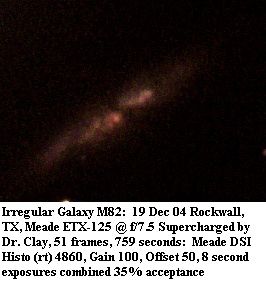
Subject: Meade Deep Sky Imager- Pics Sent: Monday, December 20, 2004 15:02:11 From: Jonathan Willocks (jonathanwillocks@hotmail.co.uk) I've been trying to get used to the Meade DSI for a few nights now. I have used the LPI in the past and initially thought the results were superior to the DSI for lunar and planetary work. However after much perseverance and fiddling with histogram sliders and exposure settings, the DSI turns out to provide the better images. Next step is an f/3.3 focal reducer to get some wider field deep sky shots, in fact the DSI is pretty usesless on most popular Schmidt-Cassegrains without a reducer in my opinion; the fileds are too narrow and exposures need to be quite long to get good detail which leads to trailing problems. It says on the box the focal reducer is a recommended option, more like essential! Anyway, here are a few of my humble efforts.Regards, Chris Willocks UK
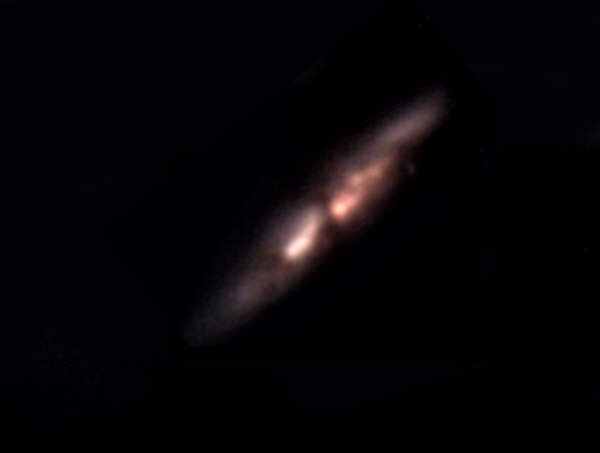
Subject: Meade DSI: Wide field images Sent: Monday, December 6, 2004 18:14:23 From: Graham, John L (Graham@udri.udayton.edu) For wide field work I've gotten reasonable results using the DSI fitted with a 50mm f/1.8 lens scavenged from an Olympus OM-1 35mm camera. I've attached two early examples using this lens. The first is of the double cluster taken my second night out with the DSI. The source image was 10x60sec, auto-contrast, soft color balance and post-processed with a logarithmic stretch of the RGB planes using the Autostar Suite IP software. The second is a picture of M31 taken using 10x60sec exposures, soft color balance, and a histogram fixed at 12,000-29,000. The source image was post-processed to reduce the background sky glow. Finally, for objects that aren't too big you can take overlapping images and tile them together is a mosaic. The attached picture of M42 was assembled from thee source images 6x15sec exposures each, soft color balance, and a histogram fixed at 4,000-30,000. The mosaic was processed with logarithmic stretches of the red and blue channels, a linear stretch of the green channel, cropped then resampled to reduce the size to 600x450.-John
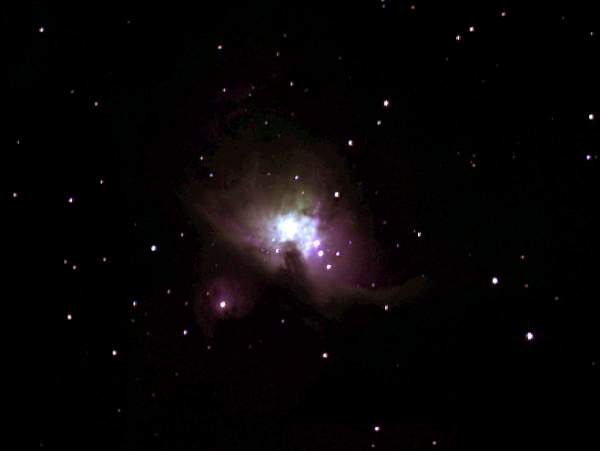
Subject: Meade DSI: First pics Sent: Monday, December 6, 2004 06:25:49 From: Graham, John L (Graham@udri.udayton.edu) I had pretty good luck my first night out with my new DSI. This was the evening of November 25th and it was clear, but there was also a nearly full Moon in Taurus. Given the bright sky my first targets were open clusters; NGC 1647 in Taurus and M35 in Gemini. These were easy targets that even turn out well with the LPI. I put off trying to image M42 in Orion until last thinking the nearby Moon would wash it out. Much to my surprise it did a fine job. Attached are two examples. The first was a single source image consisting of 10x5sec exposures taken with the histogram fixed at 4,000-16,000 and a soft color balance. The second is a composite of two images; one 10x10sec using sharp color balance the other a 20x5sec using a soft color balance. Like anything else there is a learning curve for the DSI, but you can start taking neat pictures your first night out. I do recommend reading the manual and working with the software a bit before trying it out. The DSI is easy enough to make it relatively easy to use, but sophisticated enough to do a lot with and it's the later that offers a lot of growth and potential challenges. -John
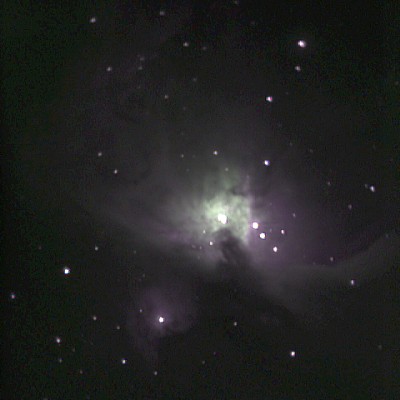
Subject: hello from New Zealand From: Stu Park (parkdales@gmail.com) Date: November 28, 2004 00:51:15 PST Hello all, My name is Stuart Parker and I live in New Zealand .I have been interested in Astronomy for 18 years and I currently have a 12 inch Meade GPSLX200.I have had it now for about a year. This telescope has really changed my Astronomy. I have never really done any photography but have got interested in the LPI and DSI. I have done some work with the LPI with mixed results. I have just got the DSI for a Christmas and haven't tried it yet. I have imaged a lamp post on my laptop with the DSI and getting used to the controls. What I have found so far is that my laptop was running a USB ver 1.1.This was a recommended on the box but at the telescope it didn't work very well it was to slow. I got a USB ver 2 card for my laptop this made all the difference. So I would really say that you need at least USB ver 2. I hope I can get some good ideas off all of you. I especially need help with image processing .I have not had much experience with that. I look forward to your comments. We have had really bad weather in the past few months so I hope that it clears soon so I can post some images to see what you guys think. Have any of you got tips for the first night out???. One thing I would say now is that I don't think you would get the images on the box in your first night. I think it will be harder than that. Thanks Stu Parker.Mike here: PLEASE read the Email Etiquette item on the ETX Site Home Page; your message was originally DELETED UNREAD as SPAM due to the non-specific SUBJECT entry.
Subject: ETX -> User Image -> DSO -> m15 Sent: Monday, November 8, 2004 12:48:07 From: Justin J. Jerzak (jjerzak@terrasite.com) Here's a shot of M15 from the Meade DSI on an etx 125 and an FR forget which one I used.Best regards, Justin Jerzak http://astro.jerzak.com 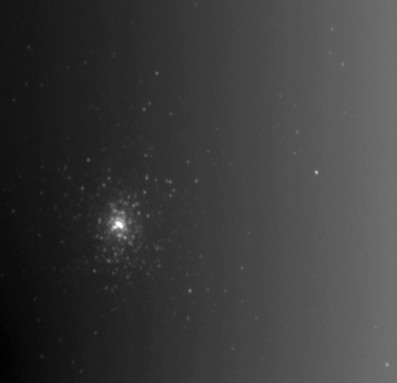
Subject: "Deep Sky Imager" first pic. Sent: Saturday, November 6, 2004 05:38:17 From: Yoshi-K (yoshi@galaxies.jp) My "Meade Deep Sky Imager" first pic. ETX-105, Deep Sky Imager Camera + FR-6.3x2 + LPS-P1, "DSI Imaging" with 20sec. 5 frame combine.And:http://etx.galaxies.jp/ 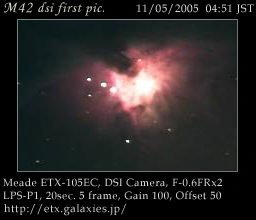
My "Meade Deep Sky Imager" second pic. ETX-70AT, Deep Sky Imager Camera, "DSI Imaging" with 15sec. 5 frame combine.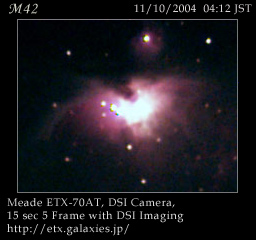
Subject: Meade Dep Sky Imager Sent: Monday, November 1, 2004 11:02:40 From: Tony (12mistydale@tiscali.co.uk) Hi there. I have just bought an ETX125 and am thinking about getting a Meade Deep Sky Imager to go with it. Have you had any experience with this imager? Regards Tony.Mike here: Not personally.
Subject: DSI Imager Software Sent: Tuesday, October 26, 2004 17:37:17 From: Tim Hoerig (timhoerig@earthlink.net) The settings dialog in the DSI Imager software, running on my Windows 98 SE machine, is clipped and a few of the functions are not available, especially the "OK" button. Anybody else seen this problem? I have a practical workaround, though tedious, other than <ctrl><alt><delete>. Hit <tab><return>, eventually you'll <tab> to "ok". There's a couple of file dialogs you might hit, just cancel, and <tab><return> some more. I don't know what the file dialogs are, as those are some of the clipped functions. Thanks, Tim Hoerig
Subject: Meade DSI - First report! Sent: Tuesday, October 26, 2004 07:36:53 From: Roy (roymc@frontiernet.net) Since I am one of the first to get a production model of the Meade DSI CCD camera, I thought I would share my experiences. I spent three days trying to get the thing to work. I kept getting "No Imager" faults every time I tried to run the software that controls the camera. After much frustration trying to get the camera to work, I tried installing the software and camera on my desktop. It finally worked after several tries. I say several tries meaning installing and re-installing the USB drivers but it finally worked. I persisted in trying to get the DSI to work on my notebook. My notebook is a Dell Inspiron 8600 less than a year old. It is a wide-screen 1.4 GHz Centrino system with wireless networking and 256 Meg of ram. It is a really "primo" machine. I finally got it to "see" the camera and thought I had it made. I later installed Desktop Universe and the drivers wouldn't work anymore. More frustration followed trying to get it going again. Since my wife wanted a notebook anyway, I decided to buy myself a new notebook and give her my Dell. I purchased an HP Pavilion that was configured similarly to my Dell except that it didn't have a wide-screen. I tried to install the camera and drivers. To make a long story short, I couldn't get the CCD camera to work on the HP either. Before you blame me for ineptness, understand that I owned and operated a computer sales and service center for several years, and I have also received several prestigious awards for my shareware programs. Failing to make the HP work with the DSI, I returned it to Staples. One thing that the HP Windows OS told me was that I was trying to connect a high speed USB device to a low speed port. I knew that was not correct. By the way, I have seen some bad PCs in my twenty plus years experience in the computer industry, but few PCs suck as bad at the HP that I bought. Machine CPU speed was 1.6 Ghz at first, but after about five minutes the machine bogged down and would not run faster than 508 MHz - even after cooling down (assuming it heated up after only 5 minutes). When I returned the PC, the clerk at staples said that at least 90 percent of their returns are HP products her words not mine lesson learned. Back to the story. On a whim I checked my Windows version. I was running XP with service pack 1. I downloaded service pack 2 and installed it on my system. It worked, and it worked well. I have installed a ton of software on my PC since, and the DSI still works. My wireless network still works and I am now trying to learn the camera system. One caveat about the DSI software is that the interface is the LPI interface, seemingly modified to work with the DSI. There is virtually no online help for the DSI. When you click on the Help tab, the file is headed "Meade LPI Camera Program The Basics". What little help there is, is in the form of a manual that you must print yourself from the supplied CD. There is very little in the way of explanation. It tells you what to do in terms that (at least for me with no CCD experience) are vague, with no explanation of why you need to do it, or what the result will be. Another thing that I didn't like was that the manual printed in landscape orientation, so you have to hold the pages sideways to read them not that the manual is of much use. I played with the software and figured out most of the features. I took the camera outside and installed it on my scope, hooked everything up, and applied what I had learned. Once I got the hang of how to use it (the manual suggests that you train yourself in the daytime and so do I) I was not impressed with the roof I was looking at from two miles away. It wasn't too bad, but I couldn't focus the camera to my satisfaction. I still haven't been able to look at the night sky, so I still have hope that performance is as good as Meade advertises. For the record, I have a 12" Meade LS200-GPS. I have read suggestions that using a parafocal lens helps in initial focusing, and I must agree that the suggestion makes good sense. I have also read that the ring is not necessary since the camera focal plane is nearly the same as a lens. Maybe, but I think it would depend on the lens used. To my surprise, I had to place the parafocal ring on my lens and not the camera. I setup a 26-mm Plossel (I had two) with the ring so I can find and center objects with the lens, then install the camera. I have a flip mirror on the way, as well as a 3.3 focal reducer since my scope is an f/10 scope. I played with the scope, software and camera most of the day. I feel confident that I can operate it well enough to take pictures of deep sky objects. Unfortunately, the weather will not cooperate, and more clouds and rain is on the way. I live in the Pacific Northwest, so I am used to waiting on the weather. Hopefully the DSI will provide hours of entertainment for my wife and I. If it turns out to be as much fun as we think it will, a new SBIG will be a must. Roy F, McCabe roymc@frontiernet.net
Subject: DSI or LPI Sent: Saturday, October 23, 2004 10:27:30 From: sheldon@mydigidocs.com Thanks for the detailed website. I have found nothing else like on the internet. And I have been looking around for a number of years! I have an ETX 125 and would like to play around with imaging. I am looking at both the LPI and the DSI. My question is this: I don't mind paying the extra money for the DSI if it will do all that the LPI will do and more. Are there any special considerations with the DSI as compared to the LPI? My main goal is quality. Will I ever get out to a super dark area and deep space image? Occasionally but most likely I'll sit in my back/front yard most of the time. Your input is appreciated and keep up the great work. Regards, SheldonMike here: If you don't have dark skies the DSI may yield less than satisfactory results vs what you would get with dark skies. However, if your intention is to capture DSOs then the decision is made; the LPI won't do as well as the DSI.
And:
I appreciate the response. Do you feel that the DSI would take better planetary images than the LPI due to its higher degree of sensitivity? Thanks again for the prompt response.Mike here: Well, I would think it should get the same results with a shorter exposure.
And:
Interesting. I am guessing that both would require a focal reducer in some situations and I am looking at the SBIG f5/f3 combo for $65. That seems like a good deal. So really unless I will commute to some really dark skies the end result will be much the same. Any experience with the SAC series of cameras? I am not opposed to getting something not made by Meade. I'm just looking for the best overall and keeping it less than $400. Once again, thank you for all the great information. SheldonMike here: I have used the SAC IV with my ETX. See the SAC imagers page on the Helpful Information: Astrophotography page. For SCT focal reducers you will need a SCT Accessory Adapter for use on the ETX. See the Accessory Reviews: Miscellaneous page.
And:
Kind of funny but I discovered that I had close to $100 in Discovery dollars so I went ahead and ordered the Meade LSI. I will let you know how it works out. For about $70, it's an almost no lose situation! I also called Meade and they mentioned that the LSI has the ability to focus so a focal reducer isn't really necessary. Does this coincide with your information? I also called Meade and they mentioned that the LSI has the ability to focus so a focal reducer isn't really necessary. Does this coincide with your information? Regards, Sheldon BernsteinMike here: A focal reducer lengthens the effective focal length of the telescope/imager system. It has nothing to do with focusing itself.
And:
They were referring to zoom in and zoom out thereby being able to image the entire moon for example. Whereas with the DSI one would need a focal reducer to fit that large of an object into one frame.And:
I noticed in one of your responses you mentioned being able to use the LPI in the rear mounting area with the Meade erecting prism and then being able to flip back and forth between the eyepiece and the LPI. Would the LPI be roughly focused using a 26mm eyepiece because both the LPI and the eyepiece have the extra "bend" in the light path. I realize I'll need to polar mount for this setup to function safely. I appologize for not going all the way back in the posts to learn that even though Meade told me a focal reducer was not needed it really is if one wishes to image the moon. With the erecting prism, which focal reducer would you recommend? Or would I just attach the LPI directly to the reducer? SAC Imaging sells a focal reducer for the eyepiece but I think it to be more advantageous using the flip mirror. I'll need to order a reducer overnight to hopefully have it for the eclipse. I'll be doing most of my "training" tomorrow night in preparation. Thanks again.Mike here: You can use a focal reducer (or the Shutan Wide Field Adapter that I talk about on the Accessory Reviews: Showcase Products page). It may possible to make eyepieces and the LPI parfocal but you will have to experiment a lot to get it right; and it will depend upon the eyepiece used.
Subject: Answer for posted question - regarding Meade DSI Sent: Friday, October 22, 2004 13:56:33 From: Justin (jjerzak@terrasite.com) You were asked a question regarding Focal Reducers for the DSI: >Subject: ETX-125 and the DSI >Sent: Thursday, October 7, 2004 22:03:27 >From: rwiley@dallas.net (rwiley@dallas.net) Here's some info for you that may help Mr. RWiley: Check this out: I had Mike Fowler from OPT http://www.optcorp.com/ check into this for me. The following reducers currently on the market that will allow your DSI to be used in the EP port of your ETX giving you better range of motion for your scope: SBIG FR-237 with efinder ( $245 over kill with extra hardware ) www.optcorp.com/cart/ProductDetail.asp?PR_ProductID=1045 SAC f/5 f/3 Focal Reducer ( $65 no quantitative disadvantage over SBIG FR ) www.optcorp.com/cart/ProductDetail.asp?PR_ProductID=2457 Best regards, Justin Jerzak http://astro.jerzak.com
Subject: ETX-125 and the DSI Sent: Thursday, October 7, 2004 22:03:27 From: rwiley@dallas.net (rwiley@dallas.net) First, let me thank you for your incredible efforts in making the Mighty ETX Website one of the finest resources for folks using the ETX (and other) lines of scopes. As an amateur, I have gained a wealth of information over the last year! My questions pertain to the use of the upcoming Deep Sky Imager (DSI) specifically with the ETX-125: 1. While I understand the DSI will insert directly into the 1.25" eyepiece aperture on the ETX-125, won't a focal reducer be required to increase the speed of the scope and FOV? And if so... 2. Does this relegate DSI usage, in the case of the ETX-125, to the rear port? And if so... 3. Will the standard Meade 6.3 or 3.3 focal reducers fit the rear cell of the ETX-125 or will it be necessary to use the 'Field Doubler' from Scopetronix to offer some form of speed increase (f/15 to f/7)? And if so... 4. Do you know what adapters, if any, will be required between the DSI and the Scopetronix 'Field Doubler' or will they mate as is? I ask these questions because I have received some information that stated the Meade focal reducers will not fit the ETX-125 and that if an ETX-125 owner wants to use the pending DSI effectively (i.e. wider FOV), that our only option is indeed the Scopetronix reducer. Can you confirm? Many thanks in advance and clear, dark skies! Robert Wiley McKinney, TX.Mike here: I suggest watching the Helpful Information: Astrophotography page for more info on the DSI as it becomes available. As to your questions, yes, the DSI fits into the eyepiece holder (just like the LPI) but whether it will REQUIRE a focal reducer remains to be seen. If you use a focal reducer (or wide field adapter) that mounts at the rear port, then that's where it mounts but there is nothing wrong with that (although for some orientations you may need to use Alt/Az or Polar mounting as necessary). To use the Meade SCT focal reducer you would need to get a SCT Accessory Adapter (see the Accessory Reviews: Miscellaneous page). I have used the Shutan Wide Field Adapter on my ETX scopes (see the Accessory Reviews: Showcase Products page) (but not yet with the LPI).
Subject: Meade Deep Sky Imager (DSI) Support Web Site and Image Gallery Sent: Tuesday, October 5, 2004 19:26:26 From: JRGriggs01@aol.com (JRGriggs01@aol.com) I thought I'd call to your attention the Meade DSI / LPI Support Web Site that I began and manage to provide information and support for the soon-to-be-released Meade Deep Sky Imager. The Web Site provides information, the DSI manual, and an Image Gallery on which images taken with the DSI and LPI may be published. You may wish to announce these links to your community: Meade DeepSkyImager eGroup: http://groups.yahoo.com/group/DeepSkyImager/ Meade DeepSkyImager Support Web Site: http://meade4504telescopes.org/DeepSkyImager/ Meade DSI / LPI Image Gallery: http://meade4504telescopes.org/DeepSkyImager/Gallery/ Thanks, and Best Regards! Jim Griggs Chicago, IL DeepSkyImager eGroup Moderator/)Owner
Subject: LPI Install on a Mac Question Sent: Saturday, October 2, 2004 10:03:57 From: Donti@aol.com (Donti@aol.com) Really this is a question about your setup using VirtualPC 6.1 w/Win 2000 & Autostar and Meade's new product Deep Sky Imager, DSI. Which is not released yet, but soon, I'm on the waiting list. I'm thinking of using a white ibook 600mhz speed w/VirtualPC & win 2000 to run the DSI on my ibook. Do you think that the processor will be powerful enough to run the software and process the images? After reading the User Manual for the DSI product, it's needs USB 2.0. From your work with the above configuration, do you know if USB 2.0 is available? I found your work on with the LPI very informative and have read them many times to become familiar with the setup and install problems that you works out using the above combination. Will you/can you also do the same using the DSI product? You site has been a great reference point for me, I'm a LXD55 10"SN owner and now want to get into imaging. Please keep up the great work that you do, especially the work using the mac. Thanks, DonMike here: The iBook probably won't have the horsepower to drive both Windows and the LPI or the DSI satisfactorily. I have used my Powerbook G4/1GHz, which worked fine. As to USB 2.0, I don't know whether that transfer rate is really required for the DSI but if I do get a DSI we'll find out how well it works with a G4 and USB 1.1.
And:
Well that changes my thinking a little bit. I do have a 1ghz/G4 ibook that I could use, it replaced my 600/ibook, but I guess I could switch back in the way I was planning to use the two ibooks. There's a group on yahoo at: http://groups.yahoo.com/group/Meade_DSI Which prompted my question about the USB 2.0. The DSI uses a 16 bit (x 3 colours) camera, where as the LPI is a 8 bit camera. Most of the users in the group sound like Window users, so for them, USB 2.0 is an easy upgrade. Thanks for the infor, I'll keep crusing your site for a DSI update. DonAnd more:
FYI, someone from the DSI yahoo group wrote in the following: >Been using the DSI with an older DELL, USB 1.1 only. >Works fine for deep sky imaging, haven't really >tried any exposures shorter than around .5 seconds >but it should be just fine. Obviously USB 2.0 would >give you faster download. You can get PCMCIA - USB2.0 >convertors for around $30. Hardly the cost of a >new laptop. Looks like I have the answer to my original question. I'm starting to build my virtual PC using my 1ghz ibook. Don
Subject: meade deep sky imager Sent: Monday, September 27, 2004 08:01:56 From: ronald hotimsky (r.hotimsky@skynet.be) hello, I own an ETX-EC and would like to know if buying the new Meade imager for use with my telescope make any sense. I live in a city with typical light and other pollutions(Brussels - Belgium as a matter of fact) . Best regards and thank you for whatever advice you might give me Ronald HotimskyMike here: You will need dark skies to take advantage of deep sky photography.
Subject: deep sky imager Sent: Friday, September 10, 2004 13:12:47 From: Saverio Riboli (saverioriboli@hotmail.com) What do you think abouth the new deep sky imager of the meade? Is a good ccd?Mike here: I have no direct experience with it but it does look like it performs nicely.
Subject: Deep Sky Imager
Sent: Saturday, September 4, 2004 16:24:02
From: Douglas G.Canard (dcanard@cswnet.com)
I always wondered after I started using my PC 164C with that
supersensitive EX-HAD chip inside it when the next leap would be made
and color-imaging of stars and faint objects would be possible in a
simple plug and play kind of way. It looks like Meade did it! Are those
pictures on the website for real?-- I thought to myself when I saw the
ads and checked into it further--No Photoshop or other extraneous
enhancements involved? Nice!
I was thinking of getting a Stellacam II because no PC would have to be
lugged outside, but this changes everything if the DSI performs as
advertised at less than half the price of no-hassle B&W imaging from the
Stellacam, which does not naturally perform well on brighter objects
like the moon and planets from what I've read unless polarizers are
used. Besides, we're dealing with no-hassle COLOR imaging done
automatically {and cheaper} even if a PC has to be lugged outside--
unless it's possible to rig up a cable around 100 feet long between the
DSI and a PC?
Would it be possible to transfer DSI images from a PC onto a standard
commercial DVD recorder like a Cyberhome or Sanyo, etc. so I can create
DVDs that people I know who don't own a PC can view on their DVD
players? A Stellacam or my PC-164 can easily be plugged straight into a
VCR, DVD recorder or just a regular television. I'm curious how easy or
difficult it might be to ultimately do the same with the DSI, regardless
of a PC being required for processing the images.
Thanks
Mike here: If you can DVDs that will play on a set-top DVD player with your PC then it doesn't matter the source of the images/movies that you put on the DVD. As long as you have the proper software. I use Mac OS X and make lots of DVDs that play on the TV or PC/Macs with DVD drives.
And:
I guess I better check first and see what recordable format my
girlfriend's DVD player can handle {+ or - R/RW or both} if at all,
before shelling out some money for a drive.
Much appreciated, Mike!
Mike here: Keep in mind that video DVD uses a different format of files than data DVDs. If you want to show the still images or movies on TV players you need to use the right software to properly encode the data. Macs come bundled with iMovie, iPhoto, and iDVD which work together to create your masterpiece. There are other commercial (professional) applications as well. I'm sure there are similar (but less easy to use) high-end products for Windows.
And:
I was curious and loaded a free AOL disc I received in the mail into my DVD player. A track list was displayed that looked similar to the lists for music CDs. That's about all it would do. I must of caused major confusion in the player. The disc would not eject until I recycled the main power switch in the back of the console. I'll not do that any more.Mike here: The CD-ROM format is different than CD or DVD. That is probably the problem.
Subject: Deep Sky Imager Sent: Monday, August 23, 2004 13:08:57 From: Schilling, Henry (HSchilling@birch.com) What new Meade Deep Sky Camera? http://astronomics.com/main/product.asp?catalog_name=Astronomics&category_name=Home&product_id=ASDSI Not much info out about it yet. hjs Henry J SchillingMike here: This is in addition to the link mentioned below.
Mike here: Meade has announced the Deep Sky Imager.
Return to the top of this page.
Go back to the Astrophotography Page.
Go back to my ETX Home Page.